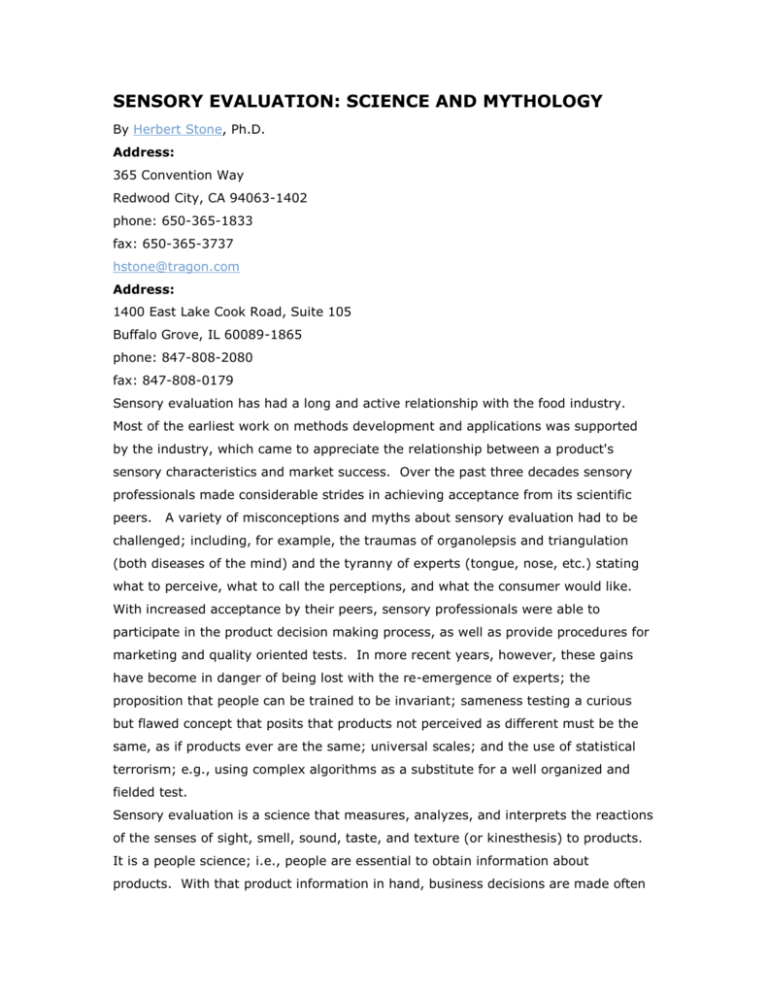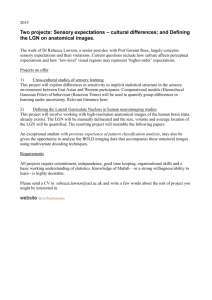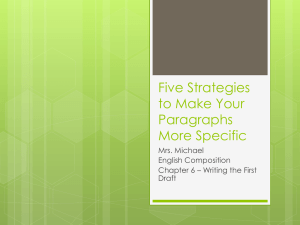SENSORY EVALUATION: SCIENCE AND MYTHOLOGY
advertisement

SENSORY EVALUATION: SCIENCE AND MYTHOLOGY By Herbert Stone, Ph.D. Address: 365 Convention Way Redwood City, CA 94063-1402 phone: 650-365-1833 fax: 650-365-3737 hstone@tragon.com Address: 1400 East Lake Cook Road, Suite 105 Buffalo Grove, IL 60089-1865 phone: 847-808-2080 fax: 847-808-0179 Sensory evaluation has had a long and active relationship with the food industry. Most of the earliest work on methods development and applications was supported by the industry, which came to appreciate the relationship between a product's sensory characteristics and market success. Over the past three decades sensory professionals made considerable strides in achieving acceptance from its scientific peers. A variety of misconceptions and myths about sensory evaluation had to be challenged; including, for example, the traumas of organolepsis and triangulation (both diseases of the mind) and the tyranny of experts (tongue, nose, etc.) stating what to perceive, what to call the perceptions, and what the consumer would like. With increased acceptance by their peers, sensory professionals were able to participate in the product decision making process, as well as provide procedures for marketing and quality oriented tests. In more recent years, however, these gains have become in danger of being lost with the re-emergence of experts; the proposition that people can be trained to be invariant; sameness testing a curious but flawed concept that posits that products not perceived as different must be the same, as if products ever are the same; universal scales; and the use of statistical terrorism; e.g., using complex algorithms as a substitute for a well organized and fielded test. Sensory evaluation is a science that measures, analyzes, and interprets the reactions of the senses of sight, smell, sound, taste, and texture (or kinesthesis) to products. It is a people science; i.e., people are essential to obtain information about products. With that product information in hand, business decisions are made often with major economic impact. This people testing process may seem simple enough; however, there are numerous ways by which one goes about deciding who in the population will participate, how they will be tested, and what kinds of questions will be asked. Much research has been done to understand consumer behavior and there is no doubt much more will be done before we have a better understanding of consumer choice behavior. In this work, one regularly encounters myths about consumer behavior that defy established knowledge about the anatomy and physiology of the senses and observed response behavior. One of these myths is the proposition that consumers can be trained to be invariant. Subjects providing the same response each time a specific stimulus is presented is used as evidence of the validity of this approach, where as it is confusing reliability with validity and using a form of behavior modification to fool us into thinking that individuals trained to provide the same response to a stimulus is realistic response behavior. For statistical wimps this concept of subject invariance has the added advantage of avoiding statistics entirely. Perceptual skills vary considerably; about 30% of any population cannot differentiate at or above chance among products that they regularly consume. This knowledge is either ignored or summarized in ways that mask differences, and leads to sensory evaluation being labeled as an inexact science. Another myth focuses on the use of lists of words that describe a product, often referred to as "lexicons" and the implication that the use of such lists will yield a universal language (the aura of a periodic table of the sensory elements for products). This has enormous appeal as it avoids the difficult task of asking a panel develop its own language, avoids translations, and has an aura of scientific respectability as such lists are usually prepared by professional committees. Requiring a panel to use only certain words has numerous faults. To a considerable degree, it is nothing more than the reappearance of language that used in product standards of identity about 50 years ago. It ultimately was found to have little or no relationship to consumer preferences or purchase behavior. Words used to represent sensations are nothing more than labels and assumptions as to causality are not sustainable without appropriate experimentation. The idea that with such a list the sensory evaluation of products is easily achieved impugns the science of sensory evaluation, the perceptual process, and raises questions as to the role of sensory evaluation within the business environment. The idea of a universal scale in sensory evaluation is another myth that has considerable appeal but is equally false. It ignores the most fundamental of issues, namely, that each person is uniquely different. Mathematically, one can produce a universal scale but at what expense? Human sensory behavior is far more complex than what some might like to believe. Any population will exhibit a wide range of sensitivities and preferences; trying to eliminate or mask such differences does not do justice to the science of sensory evaluation nor does it provide confidence in business decisions. Sensory professionals and food science professionals as well, need to recognize these myths and respond to them as they would to snake oil, with all due respect for reptiles. More Articles








